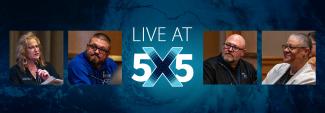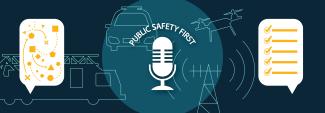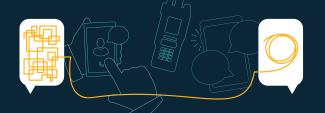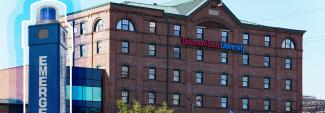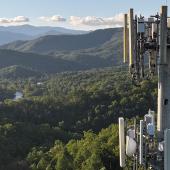Summary
Harris County, Texas, was one of the early adopters of FirstNet. As the nation’s third most populous county, first responders in the area need to be prepared for any event. The Harris County Radio Services Organization operates the regional radio system for public safety in Harris County, and FirstNet is allowing them augment that radio system in remote areas and in times of heavy network congestion.
Guest
Thomas Randall
FirstNet Authority Senior Public Safety Advisor
Greg Jurrens
Senior Manager for Radio Services, Harris County, Texas
Transcript
Preview
Narrator: You're listening to Public Safety First, a podcast to help you learn about the First Responder Network Authority and how you can be part of the future of public safety technology.
And now, your host.
Thomas Randall: Welcome to the Public Safety First podcast. I’m Thomas Randall, and I serve as a Senior Public Safety Advisor with the First Responder Network Authority. I’m joined today by Greg Jurrens who serves as a Senior Manager for the Harris County Radio Services Organization within Houston, Texas. The Radio Services Organization is responsible for supporting the county’s land mobile radio [LMR] communications network and supporting public safety agencies with emergency communications planning. Thank you, Greg, for joining us today and welcome to the podcast.
Narrator: You're listening to Public Safety First, a podcast to help you learn about the First Responder Network Authority and how you can be part of the future of public safety technology.
And now, your host.
Thomas Randall: Welcome to the Public Safety First podcast. I’m Thomas Randall, and I serve as a Senior Public Safety Advisor with the First Responder Network Authority. I’m joined today by Greg Jurrens who serves as a Senior Manager for the Harris County Radio Services Organization within Houston, Texas. The Radio Services Organization is responsible for supporting the county’s land mobile radio [LMR] communications network and supporting public safety agencies with emergency communications planning. Thank you, Greg, for joining us today and welcome to the podcast.
Greg Jurrens: Well, thanks Tom for inviting me. Looking forward to it.
Thomas Randall: Absolutely. Well, first tell us a little bit about yourself, about the organization, and some of the unique challenge you face in our nation’s third most populous county, Harris County.
Greg Jurrens: Okay, well, my name is Greg Jurrens and I am the Senior Manager for Radio Services here. We actually cover a little bit more than just Harris County. We are in the third largest county in the United States, and so our radio system expands out beyond the county through what’s called the Council of Governments in Texas. We have 26 of those, but we have a rather large one down here in southeast Texas. And then beyond that, we extend down into southeast Texas and all the way up into northeast Texas. So, as a result, we support 34 counties and we have just a little over 80,000 radio subscribers. My role is to provide management, direction – and from my background as an engineer, sometimes I get to get out and get dirty and actually play radio, which is part of my technical background. So, we have a team of 40 people – engineers, field technicians, performance monitoring, programming, and several other services that we support. And my day job, if you will, is to provide a focus in the Harris County immediate area. But then out from that we support other folks. So, it sounds like a lot of work, but I have a great team and they keep the system running, mission-critical, 24/7, 365. When we’re not doing this, most of our team is also set up with FEMA as incident command folks.
Thomas Randall: Outstanding. Well, I know that you and your team live and breathe land mobile radio over there in Houston and Harris County. Can you tell us a little bit more about LMR in Harris County and what you all do specifically with that?
Greg Jurrens: You bet. Well, Harris County was one of the very early P-25 users, which is a fully digital trunked radio system. We actually have a combination of simulcast sites, you can think of those as large cells made up of sub sites and a main controller. And then we have stand-alone repeaters in the area. Our system has right at 50 towers of radio equipment, roughly 525 channels of radios, if you will, in the immediate area. As I said, they are fully P-25 trunked and we haven’t used analog in the area for about two years. We made that change – and we are now obviously keeping the system running. Imagine a big, large trunked network that happens to leak radio – is really more what it is. It’s all about routers and firewalls and switches and connectivity and I think connectivity is actually the toughest part and the hardest part to keep running from a resiliency standpoint. We’ve been lucky in that we’ve been built out completely since about 2010, but we’re growing and we’re mostly spending our time building out resiliency and recovery solutions for things like hurricanes and floods.
Thomas Randall: Absolutely. That kind of segues into one of the planned events that you guys supported and that was the funeral procession for President George H.W. Bush. You all had some interesting challenges and had a pretty unique deployment during the Bush 41 event. Can you tell me about what your role, and what the role of the team played and how FirstNet was involved in that deployment?
Greg Jurrens: Yeah, absolutely. One of the things I should have mentioned – my team also supports a fleet of deployable equipment. Fleet’s a real fancy name, we have several pieces, but we have things like COWs, which would be communications on wheels. We also have vehicle deployable radio systems to be able to put point of source communications where it is needed. Believe it or not, as built out as Harris County is, there’s still quite a few places around the area that don’t have great communications. I don’t think there’s enough money on the planet to build every single spot out. So, we have the ability to deploy everything up to, from suitcases up to large trailer-based towers, if you will, for operations.
In the case of the President Bush funeral, obviously they’ve been residents of Houston for a very long time, so we’ve been involved in the planning of that for almost 10 years. What happened, however, was at the very last minute, they threw us a wrench and it was in the form of a train. Turns out, President Bush was a huge railroad fan, and the railroad here actually even named an engine, a locomotive after him, painted it up in presidential colors and then the plan was to have the funeral in Houston with internment about 95 miles away in College Station, at Texas A&M, where his library is located. Well, that railroad line goes through some of those rural areas where I would call the coverage of our LMR system dubious – spotty, okay, maybe nonexistent in a few cases, but we, so we figured out a plan as soon as it looked like this might happen. And we were able to deploy one of our COWs in the middle, if you will, down in a hole over a rural area and be able to provide local coverage for the people that were working the train route. We outfitted the honor guard people themselves with radios tucked into their tunics with low observable microphones and speakers. So, if you saw pictures on TV, those guys and ladies had radios on them, but the problem was we needed to connect it back to our network because, like I said earlier, it’s a network that happens to leak radio.
So, what we did was, we contacted the FirstNet Authority and our Texas Statewide Interoperability Coordinator, reached out to them, and asked for support to be able to connect using FirstNet back to our core. We were able to – and we do that in some cases already, but we needed to make sure this worked for real. So, we grabbed one of our LTE go-kit lunchboxes, which consists of an LTE modem, an interface, a little small switch, a couple of antennas, and some sort of power source – usually either battery or connectivity to a car. In this case, we connected it right to our COW. Then, we had FirstNet bring out one of their SatCOLTs, which is a satellite based-cell on light truck. And so, we were able to take advantage of both the FirstNet SatCOLT plus the FirstNet AT&T infrastructure that happens to be on the ground, and we were able to stitch up that COW and add it into the system, so that as they were bringing the casket out of the church in Houston, they were communicating to people in College Station, and then were in constant communication on the train, on the vehicle supporting, even in the Department of Public Safety helicopters that were trailing the train system. Everybody was in constant communications the whole route. And as far as they were concerned, it was just one big radio system.
Thomas Randall: Great. Were there any takeaways?
Greg Jurrens: Sure. I think one of the things that people question sometimes about this Band 14, if you’re familiar with FirstNet at all, they talk about Band 14 and why it’s necessary. I will tell you from our personal experience that we tested the FirstNet connectivity, we tested general cell phone connectivity, we even tested 2 or 3 other providers and before the event, everything worked perfectly and you couldn’t, basically, tell the difference between one or the other. It was actually pretty encouraging to know. However, starting the morning of the event – and we were prepared for this – we saw the data bandwidth in that area, this rural area with basically one good cell site, one poor cell site, and our FirstNet SatCOLT that we had brought in. We saw the data bandwidth drop and start to drop pretty precipitously as people began to show up. The more people showed up, the more the data bandwidth dropped. And the latency, or the delay between the sites, started to pick up. I am exceptionally happy that we went ahead and prepared for the Band 14 deployment. We had full priority on the path between our COW and the core network, and I’m pretty convinced we would have not be able to keep a reliable connection up had we not been able to take advantage of priority through FirstNet and the Band 14 connection that was in place.
Thomas Randall: Great. Well, I know your team is leading the way in LMR innovations. Can you share other creative ways that your looking to extend LMR coverage in the county?
Greg Jurrens: So, we started out and built a couple of ‘LTE-in-a-box lunchboxes’ is what we call them and we found out they’re very productive for reconstituting rural network connectivity after an outage. You know, rural areas, we still have a lot of T1 Telco connections. This infrastructure is very old, it’s aging. The central office equipment is aging. And so, the reliability is going down. Even the phone companies are encouraging us to get off of it. But sometimes it’s just not available yet. So, we built a couple of these lunchboxes after the funeral, and not very much longer afterwards, we had a T1 outage. And one of the teams went out and set up the LTE lunchbox on FirstNet and were able to use the same core connectivity to bring that site back on. And we were actually able to reconnect that site in just a few hours. And that included about a 70-mile drive, plus a trip up the hill to get to the site. So, that sort of proved to us that it became, you know, reliable.
So, the next thing we did was we decided to expand our head-end, if you will, at the core so we could support a number of these connections at once. So, since then, we’ve actually run two radio sites and a dispatch center all at the same time, all over FirstNet LTE, after Tropical Storm Imelda last year. So, we had three sites going at the same time. And that has really shown that this is a reliable situation. So much so now that we’re working with several of the counties on the periphery of our system to actually purchase their own on-the-site equipment that they can go out and flip the switch and at least get the site back on to the network in full coverage, using LTE FirstNet. So, this is becoming our sort of go-to solution for quick turn connectivity. So, our emergency operation side of the house saw what we were doing with these boxes, so they had us build up 30 of them. And so, now we use those for tactical deployment kits for, well, we’re using them right now in terms of having mobile testing centers, deployable testing centers, we’ve got some critical infrastructure executives that need to be, you know, connected no matter what. So, we brought out FirstNet lunchboxes for them. And I say lunchbox – it’s a small, one foot by six-inch by ten-inch Pelican case with everything in it, so it’s a lunchbox-style. But we deployed 30 of those at the onset of the COVID operation.
Last fall, the folks from our county saw what we were doing with these devices and asked us to build up 70 of them to use for voter resources at the polling locations. So, those are all being used for doing data traffic. They actually dial in directly to our own Virtual Private Network. We were able to work with the FirstNet provider AT&T and create a separate access so that, so very secure. When the modem comes up, it immediately connects into a VPN, so it’s very easy for the user.
Thomas Randall: Those are definitely some innovative approaches that Harris County is using. As you see public safety communications evolve, what other capabilities or technologies would be useful to Harris County?
Greg Jurrens: We had an opportunity to deploy FirstNet early on, and we were one of the early builders of the FirstNet development. And so, during Super Bowl LI, and another event which might sound like a small thing – but the Houston Livestock Show and Rodeo is a quarter million people a day for thirty days. So, we had a really good opportunity to really test broadband connectivity in a real-world scenario in those two applications. And so, we used a lot of data connectivity, really much more than voice. We sent a lot of pictures around, we sent short video clips around. We saw the ability to communicate with location, you know, integrated location information and real high situational awareness things like, “Here’s a picture of a suspect person, we’re looking for this person. Does anybody see him?” And within 20 seconds, you know, a whole video clip comes back – “Yes, he’s walking through this archway and we’ve got somebody tailing him.”
Or in the case of the Super Bowl, some poor security guard or maintenance person parked on the wrong level of a parking garage that was off limits. And so, it’s kind of a nefarious picture, but there was a scope – a rifle scope camera shot – of this vehicle that was sent back to the command post and within seconds, the right people said, “Oh yes, he’s one of ours. We’ll get him out of there.” And so, we were able to avoid, you know, the – any sort of scary thing happening. And so, broadband works.
All that is a long way to say: we need to see the integration of all that together. We’re already evaluating, on the radio side, from a couple of different manufacturers – the synthesis of LMR and LTE. As a matter of fact, right here on my desk, I’ve got two different radios that look like radios and are radios, but they also have FirstNet SIMs in them. One of them’s got a rather large display, and we expect to be able to see good, integrated broadband data coming out on that side, while continuing to have the access to mission-critical voice on the LMR side. So, we see mission-critical data moving to the FirstNet side soon and we see, you know, while we continue to support LMR mission-critical voice – and I think ultimately those things will combine together into one.
Thomas Randall: As the FirstNet network capabilities continue to grow and evolve, let’s talk about how that would benefit your mobile command centers, your long-term deployables.
Greg Jurrens: First off, we see the data bandwidth of the wireless broadband network expanding. Now, we’re seeing the onset of technology that allows us to bond together multiple LTE streams and multiple bands in order to get high data rates off what would classically be, you know, a wireless device. And with that higher speed data, what that gives us is smaller form factor, which means lighter and faster deployment. It means now that I can send a fire chief out to an on-scene large fire and on his laptop, connected to a high speed broadband device, he’ll be able to get that full situational awareness that he’s had to radio back, if you will, to dispatch to find out things like, “Where are my teams, who’s coming, what resources are available, how much water do we have flowing?” And there’s just a whole host of things that having on-scene situational awareness will improve life safety. I mean, because it’s all about saving lives. We talk about radio-this and radio-that, and FirstNet this and that, but we’re only doing this to save lives. And so, if we can save more lives through technology, that’s what we’re going to do.
One area that I think is a concern for us and we’ve been doing experimenting with is, what we would call tactical in-building signal enhancement. And that is the need to be able to show up at a scene another school, or something like that where the school might be in a very good radio system coverage. However, with the new building techniques that are out there, leaded windows, metalized shrink wrap around the buildings to provide better energy savings. Every time they do something like that, it makes our job harder. So, we’re now working with some companies and experimenting with tactical in-building enhancement. We recently evaluated one that actually would provide both LMR enhancement and FirstNet Band 14 enhancement where we literally rolled up, stuck up an antenna, took a 100-foot cable with another antenna right in the middle of the cafeteria of this middle school and were able to – within two minutes – provide in-building coverage that was denied otherwise. So, we see that as something that, for the tactical side, is very important. Same thing with firetrucks where they roll up on scene in an area that doesn’t have good radio or broadband coverage. They’re going to need to bring their enhancement with them. Again, it’s all about enhancing their reliability and their resiliency back into the network.
Thomas Randall: Alright, so, Greg, those were some real innovative approaches, and you talked about this being lifesaving, but it’s also capabilities that continue to grow. So, as we talk about advances in public safety communications and technologies, what interests you now, or what are you excited about, or what do you see coming?
Greg Jurrens: We’re really focused now on resiliency and trying to make sure that things run no matter what. Our focus has really been trying to figure out what works and when things are good or when things are bad – I mentioned about the funeral where every cell system worked fine the day before, but as the crowds started to form, we watched the bandwidth drop, and we refer to that as a “grey sky.” You know, there’s blue sky days, there’s grey sky days, and we hope we never see black sky days, which means everything is down. But, I’ll be honest with you, that’s where we’re spending time right now, is we’ve moved out of blue sky and the easy grey sky ones to the very hard grey sky ones like, you know, these scary events where they need to have tactical communications just right now. So, we’re focused on that, and we see broadband really becoming a big part of that.
We are also looking at, “What if?” and the what if is actually, you know, black sky events, and everything from natural disasters, catastrophic events to things like cyber – we’re really focused now on trying to protect ourselves from a cyber event. So, we’ve spent a lot of time and resources to work on protecting ourselves so that we can prevent that.
And then lastly what we’re doing is looking at what can we do when it all does go down, and how quickly can we come back up. And I’ll tell you that we’re going to be out there, we’re going to get our LMR system back online, or at least some form of it, we’re really spending resources now on being able to bring up little pieces at once. And then our strategy is, we expect that the radio system will come up first, or pieces of it, and then we think the FirstNet system will come up after that, or second if you will, and we’re going to be ready to be able to use that as our connectivity. And not just in Harris County, but then also connectivity back to the rest of our state infrastructure. We’re partnered, obviously, with other regional radio systems and the Texas Statewide Interoperability Coordinator, and we’re developing a system of systems approach to being able to connect these larger regional radio systems together in times of great need. So, across the whole state of Texas, or even beyond, and we see broadband connectivity both via ethernet and LTE and satellite to be able to connect the state together or the large systems.
We’re also planning ahead for mission-critical push-to-talk. We’re on those committees helping, at least listening actively. We’re preparing for where LMR and LTE voice will connect together, and so, we’re trying to do that in a very safe and mission-critical way.
Thomas Randall: Greg, if folks wanted to know about more about what you’re doing in Harris County and some of the innovative technology that Harris County is working on, how do they contact the team?
Greg Jurrens: Probably the easiest thing is to go to your favorite browser. On the radio side, we go by the name “TxWARN” and you can Google “TxWARN radio” and you’ll get any number of hits. It will ultimately take you to our organization’s website.
Thomas Randall: Greg, it’s always a pleasure working with you and the entire team there at Harris County. I always appreciate the relationship that we have with the Harris County team, and I want to thank you for joining us today. We appreciate this.
Greg Jurrens: Well, thanks, Tom, for the opportunity. We’re so fortunate that we have a good system here and we’re always trying to make it better.
Thomas Randall: Outstanding. Well, that concludes our podcast for today. Thank you.
Narrator: Thanks for listening today. We're excited to have you join our podcast community. Make sure to subscribe on iTunes, SoundCloud, and YouTube. You can learn more about the First Responder Network Authority at FirstNet.gov and learn about FirstNet products and services at FirstNet.com.



